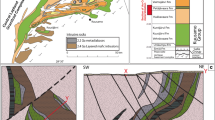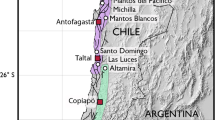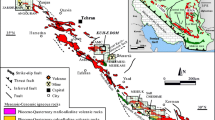Abstract
Calcite/opal deposits (COD) at Yucca Mountain were studied with respect to their regional and field geology, petrology and petrography, chemistry and isotopic geochemistry, and fluid inclusions. They were also compared with true pedogenic deposits (TPD), groundwater spring deposits (GSD), and calcite vein deposits (CVD) in the subsurface. Some of the data are equivocal and can support either a hypogene or pedogenic origin for these deposits. However, Sr-, C-, and O-isotope, fluid inclusion, and other data favor a hypogene interpretation. A hypothesis that may account for all currently available data is that the COD precipitated from warm, CO2-rich water that episodically upwelled along faults during the Pleistocene, and which, upon reaching the surface, flowed downslope within existing alluvial, colluvial, eluvial, or soil deposits. Being formed near, or on, the topographic surface, the COD acquired characteristics of pedogenic deposits. This subject relates to the suitability of Yucca Mountain as a high-level nuclear waste site.
Similar content being viewed by others
References
Archambeau CB and Price MT (1991) An assessment of J. S. Szymanski's conceptual hydro-tectonic model and its relevance to hydrologic and geologic processes at the proposed Yucca Mountain nuclear waste repository. US Department of Energy, Minority Report, Special DOE Review Panel, unpaged
Bachman GO and Machette MN (1977) Calcic soils and calcretes in the southwestern United States. US Geol. Survey Open File Report 77-794. 163 pp
Bish DL (1989) Evaluation of past and future alterations in tuff at Yucca Mountain, Nevada, based on the clay mineralogy of drill cores USWG-1, G-2, and G-3. Los Alamos National Laboratory LA-10667-NS. 40 pp
Bish DL and Aronson JL (1993) Paleogeothermal and paleohydrologic conditions in silicic tuff from Yucca Mountain, Nevada. Clays Clay Minerals 41(2): 148–161
Brogan GE, Kellogg, KS, Slemmons DB, and Terhune CL (1991) Late Quaternary faulting along the Death Valley-Furnace Creek fault system, California and Nevada. US Geological Survey Bulletin 1991. 23 pp
Chafetz HS and Lawrence JR (1994) Stable isotopic variability within modern travertines. Geograph Phys Quat 48(3): 257–273
Clayton RN, O'Neil JR, and Mayeda TK (1972) Oxygen isotope exchange between quartz and water. J Geophys Res 77: 1197–1201
Department of Energy (1993) Report on the origin of calcite-silica deposits at Trench 14 and Busted Butte and methodologies used to determine their origin. Yucca Mountain Site Characterization Report YMP/93-11-R. 64 pp
Dublyansky YV (1994a) Calcite/silica deposits and thermal springs of the Yucca Mountain area, south Nevada: Report on field trip and laboratory data evaluation. In: Livingston DE (Ed), Quarterly report no. 3 to Nuclear Waste Project Office, State of Nevada, Carson City. 114 pp
Dublyansky YV (1994b) Paleotemperature environment at Yucca Mountain, Nevada (Status Report). In: Syzmanski J (Ed), Annual report to Nuclear Waste Project Office, State of Nevada, Carson City. 77 pp
Gile LH, Peterson FF, and Grossman RB (1966) Morphological and genetic sequences of carbonate accumulation in desert soils. Soil Sci 101 (5): 347–360
Gile LH, Hawley JW, and Grossman RB (1981) Soils and geomorphology in the Basin and Range area of southern New Mexico: Guidebook to the Desert Project. New Mexico Bureau of Mines and Mineral Resources Memoir 39. 222 pp
Goff F, Wollenberg HA, Brookins DC, and Kistler RW (1991) A Sr-isotopic comparison between thermal waters, rocks, and hydrothermal calcites, Long Valley caldera, California. J Volcanol Geotherm Res 48: 265–281
Goldstein RH and Reinolds TJ (1994) Systematics of fluid inclusions in diagenetic minerals. Society Economic Paleontology Mineralogy Short Course 31. 199 pp
Harmon RS (1993) Isotopic and fluid inclusion study of Yucca Mountain samples. Quarterly report no. 6 to Nuclear Waste Project Office, State of Nevada, Carson City. 38 pp
Haskell EH and McKeever SW (1994) Determination of historical thermal gradients and dates of calcite formation using thermoluminescence, optically stimulated luminescence, and electron spin resonance analysis of minerals removed from excavated and cored samples at Yucca Mountain: report of feasibility and proposal for future studies. In: Szymanski J (Ed), Annual report to Nuclear Waste Project Office, State of Nevada, Carson City. 15 PP
Hill CA (1993) The origin of sepiolite, Yucca Mountain, Nevada. Special report no. 6 to Nuclear Waste Project Office, State of Nevada, Carson City. 12. pp
Hill CA and Schluter CM (1993) Petrographic description of calcite/opal samples collected on field trip of December 5–9, 1992. Special report no. 7 to Nuclear Waste Project Office, State of Nevada, Carson City. 20 pp
Hill CA and Schluter CM (1994) Data chart, Yucca Mountain and vicinity: Updated June, 1994. Data chart to Nuclear Waste Project Office, State of Nevada, Carson City. 60 pp
Hill CA, Schluter CM, Harmon RS, Monger HC, Schmitt RA and Liu Y-G (1994) Calcite/opal deposits at Yucca Mountain, Nevada: pedogenic or hypogene? In: Livingston DE (Ed), Annual report to Nuclear Waste Project Office, State of Nevada, Carson City. 137 pp
Ivanovich M and Harmon RF (1992) Uranium series disequilibrium; applications to environmental problems. Oxford: Oxford University Press. 910 pp
Johnson TM and DePaolo DJ (1993) Interpretation of Sr isotope data from Yucca Mountain: Modelling the effects of water-rock interaction. Lawrence Berkeley Lab., University of California report LBL-3300, UC-403. pp 18–20
Kita I, Taguchi S, and Matsubaya O (1985) Oxygen isotope fractionation between amorphous silica and water at 34–93°C. Nature 314: 63–64
Kyser TK (1987) Equilibrium fractionation factors for stable isotopes. In: Kyser TK (Ed), Short course in stable isotope geochemistry of low temperature fluids. Saskatoon: Mineralogical Association of Canada, pp 1–84
Liu Y-G and Schmitt RA (1994) Geochemical studies of vein carbonates, “true” pedogenic carbonate soils, and Paleozoic limestones and dolomites at and near the proposed Yucca Mountain high-level nuclear waste repository: In: Livingston DE (Ed), Quarterly report no. 3 to Nuclear Waste Project Office, State of Nevada, Carson City. 12 pp
Livingston DE (1993) A review of the major element geochemistry of Yucca Mountain, Nye County, Nevada. Special report no. 4 to Nuclear Waste Project Office, State of Nevada, Carson City. 48 pp
Machette MN (1985) Calcic soils of the southwestern United States. In: Weide DL (Ed), Soils and Quaternary geology of the south-western United States. Geol Soc Am Special Paper 203: 1–21
Malinin SD (1979) Physical chemistry of hydrothermal systems with carbon dioxide. Moscow: Nauka. 110 pp
Marshall BD and Mahan S (1991) A model for the formation of pedogenic carbonate based on strontium isotope data from southwest Nevada. Geol Soc Am Abstr Programs 23: A118
Marshall BD and Mahan S (1994) Strontium isotope geochemistry of soil and playa deposits near Yucca Mountain, Nevada. International high level radioactive waste management conference proceedings, Las Vegas, Nevada. American Nuclear Society-American Society of Civil Engineers, pp 2685–2691
Marshall BD, Peterman ZE, Futa K, Stuckless JS, Mahan SA, Downey JS, and Gutentag EO (1990) Origin of carbonate deposits in the vicinity of Yucca Mountain, Nevada: Preliminary results of strontium-isotope analyses. International high level radioactive waste management conference proceedings, Las Vegas, Nevada. American Nuclear Society-American Society of Civil Engineers, pp 921–923.
Marshall BD, Peterman ZE, and Stuckless JE (1993) Strontium isotopic evidence for a higher water table at Yucca Mountain. International high level radioactive waste management conference proceedings, Las Vegas, Nevada. American Nuclear Society-American Society of Civil Engineers, pp 1948–1951
Menges CM, Swan FH, Oswald JA, Wesling JR, Coe JA, Whitney JW, and Thomas AP (1994) Preliminary results of paleoseismic investigations of Quaternary faults on eastern Yucca Mountain, Nye County, Nevada. International high level radioactive waste management conference proceedings, Las Vegas, Nevada. American Nuclear Society-American Society of Civil Engineers. pp 2373–2390
National Academy of Sciences Panel (1992) Ground water at Yucca Mountain: How high can it rise? Washington, DC: National Academy Press. 148 pp
O'Neil JR, Clayton RN, and Mayeda TK (1969) Oxygen isotope fractionation in divalent metal carbonates. J Chem Phys 51: 5547–5558
Paces JB, Menges CM, Widmann B, Weslng JR, Bush CA, Futa K, Millard HT, Moat PB and Whitney JW (1994) Preliminary U-series disequilibrium and thermoluminescence ages of surficial deposits and paleosols associated with Quaternary faults, eastern Yucca Mountain. International high level radioactive waste management conference proceedings, Las Vegas, Nevada. American Nuclear Society-American Society of Civil Engineers. pp 2391–2401
Peterman ZE and Stuckless JS (1993) Isotopic evidence of complex ground-water flow at Yucca Mountain, Nevada, USA. International high level radioactive waste management conference proceedings, Las Vegas, Nevada. American Nuclear Society-American Society of Civil Engineers, pp 1559–1566
Peterman ZE, Stuckless JS, Marshall BD, Mahan SA, and Futa K (1992) Strontium isotope geochemistry of calcite fracture fillings in deep core, Yucca Mountain, Nevada—a progress report. International high level radioactive waste management conference proceedings, Las Vegas, Nevada. American Nuclear Society-American Society of Civil Engineers, pp 1582–1586
Peterman ZE, Spengler RW, Singer FR, and Dickerson RP (1993) Isotope and trace element variability in altered and unaltered tuffs at Yucca Mountain, Nevada. International high level radioactive waste management conference proceedings, Las Vegas, Nevada. American Nuclear Society-American Society of Civil Engineers. pp 1940–1947
Peterman ZE, Widmann BL, Marshall BD, Aleinikoff JN, Futa K, and Mahan SA (1994) Isotopic traces of gold deposition in Paleozoic limestones, southern Nevada. International high level radio-active waste management conference proceedings, Las Vegas, Nevada. American Nuclear Society-American Society of Civil Engineers, pp 1316–1323
Quade J and Cerling TE (1990) Stable isotopic evidence for a pedogenic origin of carbonates in Trench 14 near Yucca Mountain. Science 250: 1549–1552
Quade J and Tingley JV (1983) A mineral inventory of the Nevada Test Site and portions of Nellis Bombing and Gunnery Range, southern Nye County, Nevada. Nevada Bureau of Mines Kept. DOE/NV/10295-1. pp 31–34
Quade J, Cerling TE, and Bowman JR (1989) Systematic variations in the carbon and oxygen isotopic composition of pedogenic carbonates along elevation transects in the Southern Great Basin, United States. Geol Soc Am Bull 101: 464–475
Reheis MC (1986) Preliminary study of Quaternary faulting on the east side of Bare Mountain, Nye County, Nevada. US Geological Survey Open File Report 86-576. 14 pp
Roedder E, Whelan JF, and Vaniman DT (1994) Fluid inclusion studies of calcite veins from Yucca Mountain, Nevada, tuffs: environment of formation. International high level radioactive waste management conference proceedings, Las Vegas, Nevada. American Nuclear Society-American Society of Civil Engineers, pp 1854–1860
Sass JH, Lachenbruch HA, and Mase EW (1980) Analyses of thermal data from drill hole UE-24a3 and UE-25al, Calico Hills and Yucca Mountain, Nevada Test Site. US Geological Survey Open File Report 80-826. 25 pp
Sass JH, Lachenbruch AH, Dudley WW, Priest SS, and Munroe JR (1987) Temperature, thermal conductivity, and heat flow near Yucca Mountain, Nevada: Some tectonic and hydrologic implications. USGS Open-File Report 87-649, Denver, Colorado. 118 pp
Sowers JM (1988) Geomorphology and pedology on the Kyle Canyon alluvial fan, southern Nevada. In: Weide DL and Faber ML (Eds), This extended land: Geological journeys in the southern Basin and Range. Geological Society of America, Cordilleran section, guidebook to field trip, pp 137–157
Spengler RW and Peterman ZE (1991) Distribution of rubidium, strontium and zirconium in tuff from two deep coreholes at Yucca Mountain, Nevada. International high level radioactive waste management conference proceedings, Las Vegas, Nevada. American Nuclear Society-American Society of Civil Engineers. pp 1416–1422.
Spengler RW, Braun CA, Martin LG, and Weisenberg CW (1994) The Sundance fault: A newly recognized shear zone at Yucca Mountain. US Geological Survey Open File Report 94-49. 11 pp
Stuckless JS, Peterman ZE, and Muhs DR (1991a) U and Sr isotopes in ground water and calcite, Yucca Mountain, Nevada: evidence against upwelling water. Science 234: 551–554
Stuckless JS, Peterman ZE, Whelan JF, and Muhs DR (1991b) Isotopic evidence for aper descension origin for hydrogenic veins in faults near Yucca Mountain, Nevada. Geol Soc Am Abstr Programs 23: A118
Szabo BJ and Kyser TK (1990) Ages and stable-isotope compositions of secondary calcite and opal in drill cores from Tertiary volcanic rocks at the Yucca Mountain area, Nevada. Geol Soc Am Bull 102: 1714–1719
Szymanski JS (1992) The origin and history of alteration and carbonitization of the Yucca Mountain ignimbrites. US Department of Energy, Las Vegas, Nevada Report April, 1992. non-consecutive pages
Szymanski JS (1993) Dialogs regarding the Yucca Mountain controversy. Special report no. 9 to Nuclear Waste Project Office, State of Nevada, Carson City, nonconsecutive pages
Tingley JV (1984) Trace element association in mineral deposits, Bare Mountain (fluorine) mining district, southern Nye County, Nevada. Nevada Bureau of Mines and Geology Report 39.28 pp
Turrin BD and Champion DE (1991)40Ar/39Ar laser fusion and K-Ar ages from Lathrop Wells, Nevada and Cima, California: The age of the latest volcanic activity in the Yucca Mountain area. International high level radioactive waste management conference proceedings, LaGrange Park, Illinois. American Nuclear Society-American Society of Civil Engineers, pp 68–75
Vaniman DT (1993) Calcite deposits in fractures at Yucca Mountain, Nevada. International high level radioactive waste management conference proceedings, Las Vegas, Nevada. American Nuclear Society-American Society of Civil Engineers, pp 1935–1939
Weiss SI, Noble DC and Larson LT (1993) Task 3: Evaluation of mineral resource potential, caldera geology, and volcanic-tectonic framework at and near Yucca Mountain. University of Nevada-Reno: Center for Neotectonic Studies. 41 pp
Wells SG, McFadden LD, Renault CE, and Crowe BM (1990) Geomorphic assessment of late Quaternary volcanism in the Yucca Mountain area, southern Nevada: Implications for the proposed high-level radioactive waste repository. Geology 18: 549–553
Whelan JF and Stuckless JS (1992) Paleohydrologic implications of the stable isotopic composition of secondary calcite within the Tertiary volcanic rocks of Yucca Mountain, Nevada. International high level radioactive waste management conference proceedings, LaGrange Park, Illinois. American Nuclear Society-American Society of Civil Engineers. pp 1572–1581
Winograd IJ and Pearson FJ (1976) Major carbon-14 anomaly in a regional carbonate aquifer: Possible evidence for megascale channeling, South Central Great Basin. Water Resour Res 12(6): 1125–1143
Zartman RE and Kwak LM (1991) Lead isotopes in the carbonatesilica veins of Trench 14, Yucca Mountain, Nevada. Geol Soc Am Abstr Programs 23: A117-A118
Zartman RD and Kwak LM (1993) Lead isotopic composition of Paleozoic and Late Proterozoic marine carbonate rocks in the vicinity of Yucca Mountain, Nevada. International high level radioactive waste management conference proceedings, Las Vegas, Nevada. American Nuclear Society-American Society of Civil Engineers. pp 1953–1959
Zukin JG, Hammond DE, Ku T-L, and Elders WA (1987) Uranium-thorium series radionuclides in brines and reservoir rocks from two deep geothermal boreholes in the Salton Sea Geothermal Field, southeastern California. Geochim Cosmochim Acta 51: 2719–2731
Author information
Authors and Affiliations
Rights and permissions
About this article
Cite this article
Hill, C.A., Dublyansky, Y.V., Harmon, R.S. et al. Overview of calcite/opal deposits at or near the proposed high-level nuclear waste site, Yucca Mountain, Nevada, USA: Pedogenic, hypogene, or both?. Geo 26, 69–88 (1995). https://doi.org/10.1007/BF00768320
Received:
Accepted:
Issue Date:
DOI: https://doi.org/10.1007/BF00768320




